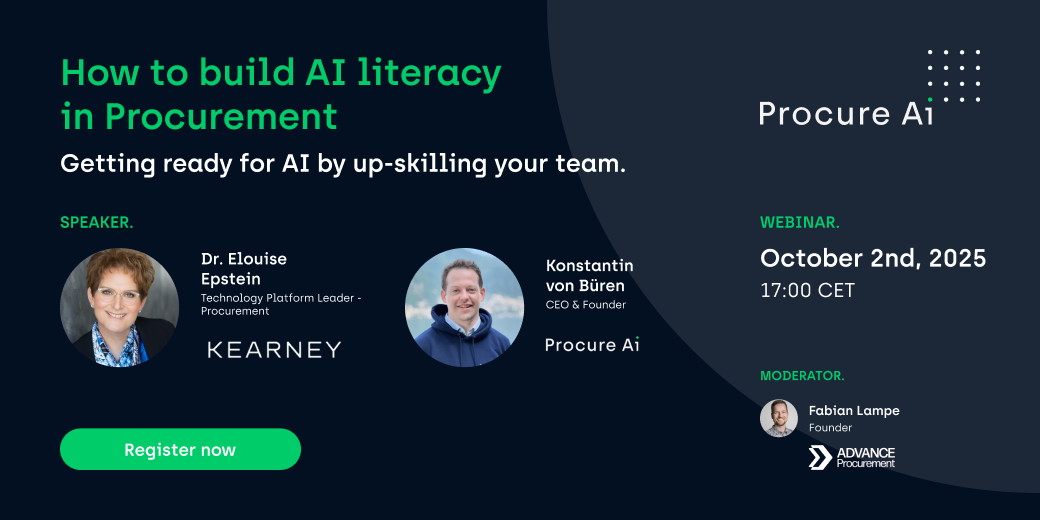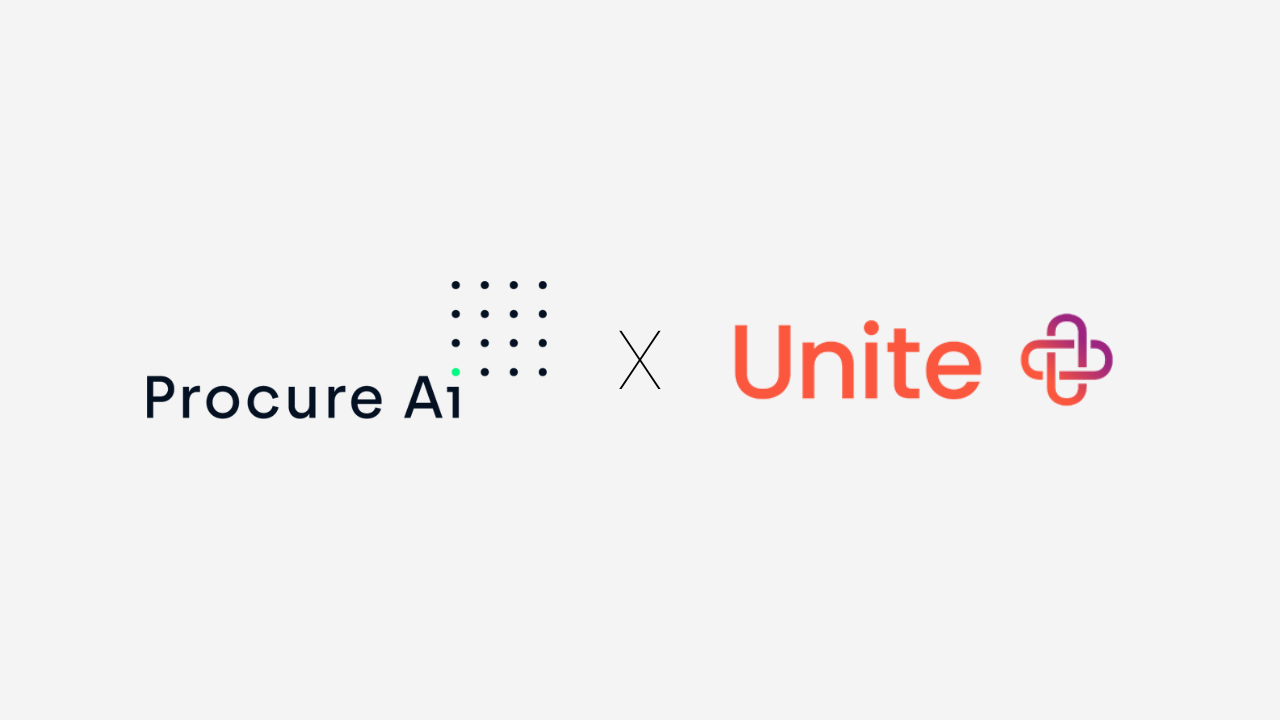

This glossary cuts through the noise with a clarity-first guide to the key terms you need to navigate the procurement, procurement technology, and AI landscape effectively. From familiar concepts like source-to-pay and contract lifecycle management to newer ideas like process orchestration and autonomous negotiation, we’ll define the essentials so you can speak about AI-driven procurement with confidence.
The fundamental terms that lay the ground work for understanding the end-to-end procurement process and landscape.
Plan-to-Strategy (P2S) covers the upstream part of the procurement process and includes spend analysis, category strategy management, and Performance Management (pipeline planning and savings or initiative tracking).
Source-to-Contract (S2C) refers to the core operational procurement processes around sourcing, negotiations, and contract management.
Purchase-to-Pay (P2P) refers to the transactional part of the procurement process and summarizes all steps from raising a purchase requisition (PR) to paying the invoice.
The full operational procurement process, combiningS2C and P2P—from sourcing and contracting to purchasing and invoice payment.
Source-to-Settle (S2S) is a term mostly used by consultants to describe the end-to-end procurement process from spend analytics to invoice payment.
The purchasing of goods, materials, or components that go directly into a company’s products or services.
The purchasing of goods and services that support operations but are not part of the final product or service.
A specialized team that provides leadership, training, and support on procurement best practices, processes, and technologies across an organization.
The process of collecting, cleansing, classifying, and analyzing spend data.
The process of evaluating an organization's expenditure data to understand spending patterns, identify cost-saving opportunities, improve efficiency, and optimize procurement strategies.
The portion of a company's procurement spending that goes toward ad-hoc purchases and uncategorized expenses. Usually, the bottom 20% of spend that accounts for 80%of transactions and suppliers.
A holistic long-term procurement strategy that groups products and services into categories based on function, usage, or supplier markets, aiming to optimize buying and supplier engagement.
A structured plan for a specific category, combining analysis, goals, market dynamics, and targeted value levers and tactics to achieve desired outcomes through demand management, sourcing, supplier management, risk management, and buying guidance.
ProcurementPerformance Management refers to pipeline management and savings tracking. It is about managing and tracking savings, demand management, supplier development, or risk mitigation opportunities and their projected impact from ideation through execution. Next to savings, other metrics like process efficiencies, CO2 reduction, or other targets are tracked and managed as well.
A targeted procurement process focused on acquiring goods and services efficiently, reducing costs, and optimizing supply channels to meet short- or mid-term business needs.
A process used to gather general information from potential suppliers to understand their capabilities and solutions. It is usually the first step of a strategic sourcing process.
A formal process inviting suppliers to submit detailed proposals for delivering a product or service, often including pricing, methodology, and timelines. Usually used when the detailed specifications are not fully established, and input on possible solutions is sought.
The process of soliciting specific price quotes from suppliers for clearly defined products or services.
A collective term for RFI, RFP, RFQ, and other similar sourcing requests used to engage suppliers during the procurement process.
The use of data analysis to evaluate supplier performance and market conditions during the sourcing process, enabling better decisions through capabilities like data cleansing, outlier detection, opportunity identification, competitive analysis, and proposal comparison.
A methodology used to evaluate and estimate thereasonable cost of a product, service, or solution. It involves a comprehensive examination of cost components, such as materials, labor, overhead, profitmargins, and other relevant factors. It is basically reverse engineering the cost of a product.
The use of linear mathematical optimization tocalculate the optimal award allocation under consideration of given businessrules and constraints. This is sourcing analytics on speed.
A potential supplier award decision based on defined business rules, constraints, and objectives. It allows procurement teams to compare different options—such as supplier combinations, volumes, or pricing—using scenario analysis to identify the most optimal outcome for cost, risk, and strategic alignment.
A structured discussion between a buyer and supplier aimed at reaching mutually acceptable terms on price, delivery, quality, or other contractual or commercial conditions.
An electronic auction conducted via digital platforms or sourcing software, creating competitive pressure among suppliers through real-time bidding, condensed timelines, and live feedback to secure the best terms and conditions.
Managing a contract from creation through negotiation, execution, compliance, renewal, or termination, the full lifecycle of it.
A centralized repository with storage, metadata, workflows, and alerts to manage contract documents throughout their lifecycle. Could be SharePoint, shouldn’t be SharePoint.
Tools and processes for drafting, reviewing, and redlining contracts collaboratively. If contract signing is part of authoring is debatable.
The umbrella term for managing an organization’s supply base with the aim of ensuring mutually beneficial business relationships.
Capturing, storing, analyzing, and updating all relevant supplier data to optimize the organization’s interactions and transactions with suppliers.
The process of monitoring, measuring, and improving supplier performance to ensure quality, reliability, and alignment with business goals. Performance management consists of quantitative elements(on-time delivery in full), product/service quality parameters(acceptance/rejection rate), and qualitative assessments in the form of surveys.
The practice ofidentifying, assessing, and mitigating risks associated with suppliers,vendors, and other external partners across risk domains like regulatorycompliance, cybersecurity, ESG, financial, or geopolitical risk domains.
The process of capturing, prioritizing, and evaluating business requests across purchasing, supplier creation, sourcing, or contracting to ensure they are handled efficiently by procurement and aligned with business objectives.
The route or method through which goods and services are purchased, such as contracts, catalogs, structured forms, marketplaces, P-Cards, category specific platforms, or free text requests.
A digital B2B platform where suppliers maintain updated catalogs of goods and services for streamlined procurement.
A curated list of approved and negotiated products or services that employees can select to streamline the purchasing process and drive process efficiency. Catalogs can be distinguished between internal, hosted, and punch-out catalogs, which determine the ownership, responsibility, and ability to make changes.
A procurement request where the requester manually specifies the product or service details rather than selecting from a predefined catalog.
A formal request to purchase goods or services, typically initiated by an employee or department, detailing the item specifications, quantities, and justifications for the purchase.
A formal document issued by a buyer to a supplier authorizing the purchase of specific goods or services under agreed terms.
The process of confirming that ordered goods have been received, inspected, and recorded in the system.
A record used to confirm that a contracted service has been delivered.
A document submitted by a supplier requestingpayment for delivered goods or services.
The process of comparing an invoice against the related purchase order (2-way match) and goods receipt or service entry sheet (3-way match) to ensure accuracy before payment.
The total elapsed time required to complete a specific procurement process or activity, from initiation to completion.
The key technology terms you need to know to successfully navigate the modern procurement landscape.
Specialized procurement software focused on solving a specific vertical challenge (e.g.,sourcing) deeply rather than offering broad functionality.
A comprehensive procurement software vendor providing capabilities across the full source-to-settle (or procurement) process, usually focused on S2C and P2P capabilities.
A software foundation that provides a standardized environment and tools for building, deploying, and managing applications efficiently.
An integrated system that manages key business functions, including procurement, finance, planning, HR, and operations.
Web-based tools that automate purchasing processes, from requisitions to order placement.
A centralized repository that can store structured, semi-structured, and unstructured data—all in one place.
A structured framework that defines the concepts, categories, and relationships between different datatypes within a specific domain.
A set of standardized rules that enables real-time communication between different software systems. APIs are used to exchange data freely between solutions.
The evolving terms that explain how AI impacts and changes procurement and the underlying technology required.
Autonomous AI systems that learn, adapt, and operate with minimal human oversight.
AI tools that create new content—like text, images, audio, or video—in response to user prompts.
The use of AI-driven systems to identify, evaluate, and select suppliers with minimal human intervention, streamlining the sourcing process. Includes supplier outreach, quote collection, and comparison to support sourcing decisions.
AI-powered tools that conduct supplier negotiations automatically, optimizing terms, pricing, and contract conditions without direct human involvement.
The knowledge and skills needed to understand, interpret, and responsibly use AI technologies in professional contexts, enabling informed decision-making.
Data cleansing
Identifying and correcting errors and inconsistencies in data to ensure its accuracy and reliability.
Organizing data into meaningful categories, such as spend types or supplier groups.
Merging data from multiple sources into a consistent, unified format.
Enhancing existing data with additional insights or external context like scores, risk assessments, etc..
Using AI interfaces (e.g., chat)to gather and refine procurement specifications autonomously.
AI-driven recommendations of relevant suppliers based on requirements and historical patterns.
The use of AI, particularly generative models, to automatically capture, interpret, and prioritize procurement requests, improving efficiency and ensuring requests are accurately aligned with business needs. The term is mostly used to describe stakeholder engagements on purchasing requisitions but also covers sourcing, supplier, or contract requests.
A design concept that keeps people involved at key decision points of a process, balancing AI efficiency with human judgment.
A field of artificial intelligence that enables computers to understand, interpret, and generate human language.
The use of AI and data-driven models to forecast future trends, supplier performance, demand, and risks, enabling more informed and proactive decision-making.
The strategic coordination of procurement activities across systems, policies, stakeholders,and data, often powered by AI.
A set of rules that define whatAI agents can and can’t do to ensure ethical, compliant, and controlled behavior.
A specific type of AI (specialist transformer) trained on massive volumes of text, designed to understand and generate human-like language.
Deep learning models used top rocess visual data like images and videos.
A type of recurrent neural network that can remember information for a long time and apply that stored data for future calculations.
A type of neural network architecture that transforms or changes an input sequence into an output sequence. LLMs are specialized transformers.
Large-scale AI model strained on broad datasets that can be adapted for multiple procurement applications, such as automating processes, generating insights, or enhancing decision-making. CNNs, LSTMs, LLMs are all foundational models.
A structured representation of data that connects entities based on relationships (e.g., linking suppliers to their contracts or risks).
Tools that represent textual or visual data as numeric vectors, enabling semantic search and meaning-based matching.
Search methods that retrieve results based on conceptual meaning rather than exact keyword matches.
The technical backbone connecting datasources, models, applications, and users.
Mastering procurement today is about more than just understanding traditional processes and terminology. It requires speaking the language of the technology and AI tools that are shaping the future of the field. By understanding the key terms we’ve outlined above, you can engage with confidence, make smarter decisions, and unlock greater value in your work. Keep this glossary close as your go-to resource on the journey to procurement excellence.
Are your eady to deepen your procurement AI expertise and boost your AI literacy? Signup for our Procurement Aicademy today.
 Procure Ai secures $13m seed funding to transform procurement through AI-native autonomous agents
Procure Ai secures $13m seed funding to transform procurement through AI-native autonomous agentsFunding will help make AI-native autonomous agents available across Europe.
News
25
 How to build AI literacy in Procurement for successful AI implementations
How to build AI literacy in Procurement for successful AI implementationsA discussion on the practical steps every procurement professional can take to build AI literacy
Webinar
24
 Ivalua x Procure Ai: Orchestrating purchasing processes to help Procurement fully leverage their S2P suite
Ivalua x Procure Ai: Orchestrating purchasing processes to help Procurement fully leverage their S2P suiteProcure Ai–Ivalua integration delivers smooth data flow, real-time requisition updates, and AI-driven automation for faster, accurate procurement.
News
23
 Seamless buying experiences: Unite’s leading B2B marketplace now available through ProcureAi’s Generative Intake Management
Seamless buying experiences: Unite’s leading B2B marketplace now available through ProcureAi’s Generative Intake ManagementProcure Ai and Unite partner to simplify B2B buying. Access Unite’s marketplace directly in Procure Ai for faster, compliant, connected purchasing.
News
22